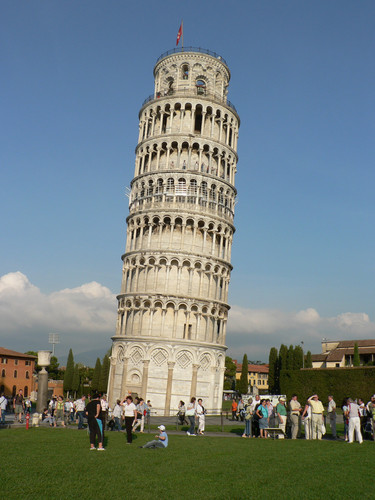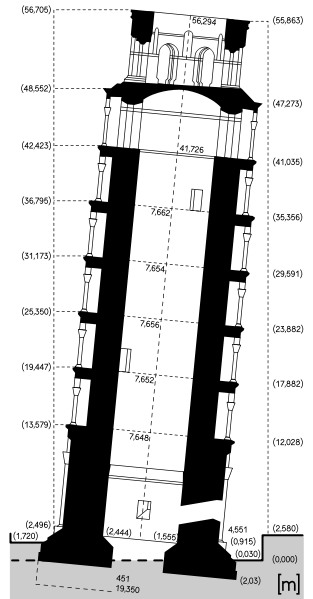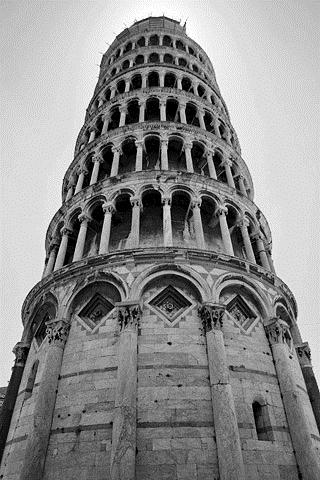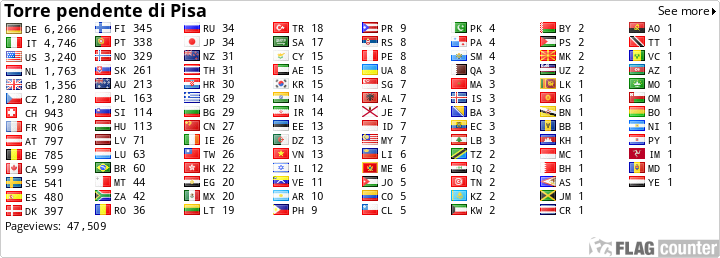Torre pendente di Pisa


Torre pendente di Pisa - In a geological perspective.
History
On the 9th of august 1173, the foundations of the tower was laid. But the work stopped in 1178. Already there seemed to be trouble with the inclination of the tower. In 1272, 94 years later Giovanni di Simone re-opened the construction site. In less than 6 years the tower reached the 7th cornice. While building he tried to correct for the towers inclination and then giving the tower it´s "banana" shape. In 1278 he gave up. Tommaso di Andrea Pisano constructed the belfry between 1360 and 1370 and finished the tower, some 197 years after the start.
Under the tower
Beneath the tower are three stratifications. The topmost is about 10m thick and of very irregular structure, made of sandy and clay silt. The lower layer is of marine origins and reaches a depth of 40 meters. This is known as the layer of hard clay.
Below this layer is accumulated sand that extends to a considerable depth. The water table is immediately under the tower, only 1-2 meters below ground level.

The anathomy of the tower
It is a hollow tower, built out of 32400 blocks of stone which form the outer and inner facing of the cylinder. The cavity between these walls are filled with stones, rubble and sand cemented together with lime mortar. Most of the building material comes from places near Pisa, like San Giuliano, Agnano and Caprona. The blocks of stone and mortar where transported via some of the many waterways in the area. In the middle ages Pisa was surrounded by marches, there were not many roads and the few ones that were could not hold the weight of these heavy transports. The weight of the tower is about 14700 tons. It was preferable to use barges along the rivers Arno and Serchio that flowed close to Pisa at that time.
An artificial canal was built in 1160, cutting thru the area northeast of Pisa. This canal connected the quarries in San Giuliano and Agnano with Pisa. Most of the stone is marble from San Giuliano, it is a very though stone and comes in several shades from
grey to white and yellow to light pink. This stone was also used in most of the important medieval buildings in Pisa. Breccia from Agnano was used during the second period of construction only and is hidden from view on the inside of the barrel. The use of that material may have been a choice to reduce the weight of the tower.

Dark grey limestone was used for the decorative stripes on the outer facing of the tower. Granodiorite from Monte Capanne on the isle of Elba can be seen in some of the half-columns at the base. Marble from the Apuan alps (Carrara) has been used
to replace many decorative structures such as capitals and pillars.

Technical information
- Elevation of Piazza del Duomo: about 2 metres
- Height from the ground floor: 55.863 metres, 8 stories
- Height from the foundation floor: 58.36 metres
- Outer diameter of base: 15.484 metres
- Inner diameter of base: 7.368 metres
- Weight: 14,700 metric tons
- Thickness of walls at the base: 4 meters
- Total number of bells: 7, tuned to musical scale
- Number of steps to the top: 296
How to log:
In order to log this  (Earthcache) as
(Earthcache) as  (found) you must do the following:
(found) you must do the following:
Optional: Take a picture of yourself with your GPS in your hand and the tower in the background.
Answer the following questions and mail the answers to the cacheowner:
1. In what direction does the tower lean? measure and answer in degrees.
2. Why is it leaning?
3. Granodiorite is similar to granite, are there any diffrence in colour?
4. The granodiorite in the tower is from the island Elba, Mont Capenne. How high is this mountain ?
5. A breccia may have a variety of different origins, how many namegroups?
You do not need to wait for approval from the cacheowner to log as found. If I need additional information, I let you know. Remember to post a picture and not to write answers in your log!


Torre pendente di Pisa – In prospezione geologica
Storia
Le fondamenta della Torre furono poste il 9 Agosto 1173, ma i lavori furono interrotti nel 1178. Già sembrava che ci fossero problemi con l’inclinazione della torre. Nel 1272, 94 anni dopo, Giovanni di Simone riaprì il cantiere. In meno di 6 anni la torre raggiunse il settimo cornicione di altezza. Durante la costruzione, egli cercò di correggere l’inclinazione della torre, ed è per questo che essa ha oggi un aspetto a “banana”. Nel 1278 interruppe i lavori. Tommaso di Andrea Pisano costruì la torre campanaria tra il 1360 e il 1370 e completò la torre, 197 anni dopo l’inizio dei lavori.
Sotto la torre
Nel sottosuolo della torre ci sono tre diverse stratificazioni. Lo strato superiore è spesso circa 10m ed ha una struttura molto irregolare, essendo un limo sabbioso e argilloso. Lo strato inferiore è di origine marina e raggiunge una profondità di 40m. E’ chiamato lo strato di argilla dura. Al di sotto di questo strato si trova un accumulo di sabbia, che si estende fino a notevole profondità. Il livello idrostatico si trova immediatamente sotto la torre, solo 1-2m dal livello del suolo.
Anatomia della torre
E’ una torre cava, costruita con 32400 blocchi di pietra che formano le facce interna ed esterna del cilindro. Lo spazio tr queste è riempito con pietre, detriti e sabbia cementati con malta. Gran parte del materiale da costruzione proviene da località vicine a Pisa, come San Giuliano, Agnano e Caprona. I blocchi di pietra e la malta venivano trasportati lungo le numerose vie d’acqua presenti nella zona. Nel medioevo Pisa era circondata da zone paludose, no c’erano molte strade e le poche esistenti non erano in grado di sopportare il passaggio di questi carichi pesanti. Il peso della torre è di circa 14.700 tonnellate. Era preferibile quindi utilizzare delle chiatte per il trasporto lungo i fiumi Arno e Serchio, che al tempo scorreva vicino a Pisa.

Nel 1160 venne costruito un canale artificiale nell’area a nord-est di Pisa. Questo collegava le cave di San Giuliano e Agnano con Pisa. Gran parte delle pietre sono in marmo di San Giuliano, è una pietra molto resistente e disponibile in varie sfumature dal grigio al bianco, al giallo e al rosa chiaro. Questa pietra è stata usata anche per la costruzione della maggior parte dei più importanti edifici medievali di Pisa. La breccia di Agnano è stata usata solo durante il secondo periodo di costruzione, ed è nascosto alla vista trovandosi nella parte interna. L’uso di questo materiale potrebbe essere stato un modo per diminuire il peso della torre. Per le strisce decorative sull’esterno della torre è stata usata una pietra calcarea color grigio scuro. Il granodiorite proveniente dal monte Capanne (Isola d’Elba) si trova in alcune delle mezze colonne alla base della torre. Il marmo delle Alpi Apuane (Carrara) è stato utilizzato per la sostituzione di diverse strutture decorative come capitelli e pilastri.
Informazioni tecniche
Elevazione di Piazza del Duomo: circa 2 metri
Altezza dal livello del suolo: 55,863 metri, 8 storie
Altezza dal piano di fondazione: 58,36 metri
Diametro esterno della base: 15,484 metri
Diametro interno della base: 7,368 metri
Peso: 14.700 tonnellate
Spessore dei muri alla base: 4 metri
Numero complessivo delle campane: 7, sintonizzata su scala musicale
Numero di gradini fino alla cima: 296
Come loggare:
Per loggare questa  (Earthcache) come
(Earthcache) come  (found) occorre effettuare le seguenti operazioni:
(found) occorre effettuare le seguenti operazioni:
Optional – Fate una vostra foto con il GPS in mano e la torre come sfondo
Rispondete alle seguenti domande e mandate le risposte via e-mail al cacheowner:
1. In quale direzione pende la torre ? Misura e risposta in gradi
2. Perché pende ?
3. Il granodiorite è simile al granito, ci sono differenze nel colore ?
4. Il granodiorite della torre viene dal Monte Capanne, Isola d’Elba. Qual è l’altezza di questo monte ?
5. La breccia può essere di varia origine, quanti tipi ci sono ?
Non è necessario attendere l’approvazione del cacheowner per loggare il ritrovamento. Se avrò bisogno di ulteriori informazioni ve lo farò sapere. Ricordate di mettere una foto e di non scrivere le risposte sul log !!!
Thank you Gigi_e_Luca for the translation!
References: The book. "The leaning tower, the restoration of the century"
Wikipedia: http://en.wikipedia.org/wiki/Leaning_Tower_of_Pisa
Visit my other Earthcaches:
Sweden:  Svedsmossen Earthcache
Svedsmossen Earthcache  Ersdalen Earthcache
Ersdalen Earthcache  Svavelbruket
Svavelbruket  Kalkbrottet
Kalkbrottet  Rosenlunds bankar
Rosenlunds bankar  Gautelfr
Gautelfr  Druim
Druim  Kamlungeforsen
Kamlungeforsen
Cape Verde:  As dunas de Bubista
As dunas de Bubista
Montenegro:  Vapnenac
Vapnenac
Croatia:  Kolac natural arch
Kolac natural arch
Cuba:  Mirador de Bacunayagua
Mirador de Bacunayagua
Greece:  Afantou beach
Afantou beach
